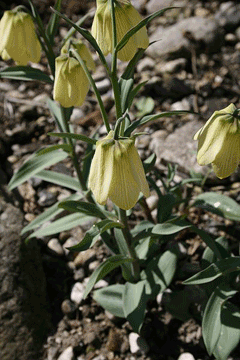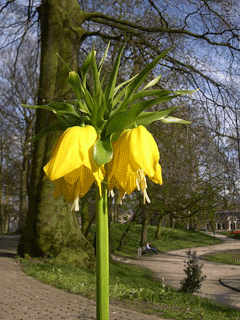 |
|
http://commons.wikimedia.org/wiki/User:KhamtranFritillaria meleagris |
 |
|
Translate this page:
Summary
Bloom Color: Orange,Yellow. Main Bloom Time: Late spring, Mid spring. Form: Upright or erect.
Physical Characteristics

 Fritillaria imperialis is a BULB growing to 1 m (3ft 3in) by 0.3 m (1ft) at a slow rate.
Fritillaria imperialis is a BULB growing to 1 m (3ft 3in) by 0.3 m (1ft) at a slow rate.
See above for USDA hardiness. It is hardy to UK zone 4 and is not frost tender. It is in flower in April, and the seeds ripen from July to August. The species is hermaphrodite (has both male and female organs) and is pollinated by Bees.
Suitable for: medium (loamy) and heavy (clay) soils, prefers well-drained soil and can grow in heavy clay soil. Suitable pH: mildly acid, neutral and basic (mildly alkaline) soils. It can grow in semi-shade (light woodland) or no shade. It prefers dry or moist soil and can tolerate drought.
UK Hardiness Map
US Hardiness Map
Synonyms
Plant Habitats
Woodland Garden Sunny Edge; Dappled Shade;
Edible Uses
Edible Parts: Root
Edible Uses:
Bulb - cooked[114]. A minor source of starch[4, 105, 177]. Some caution is advised since there are reports of toxicity.
References More on Edible Uses
Medicinal Uses
Plants For A Future can not take any responsibility for any adverse effects from the use of plants. Always seek advice from a professional before using a plant medicinally.
Diuretic Emollient Galactogogue Resolvent
The bulb is diuretic, emollient and resolvent[240]. It is also a cardiac poison[240]. It has been used as an expectorant and also to encourage increased breast milk production[254]. The fresh plant contains the toxic alkaloid 'imperialine'[240].
References More on Medicinal Uses
The Bookshop: Edible Plant Books
Our Latest books on Perennial Plants For Food Forests and Permaculture Gardens in paperback or digital formats.

Edible Tropical Plants
Food Forest Plants for Hotter Conditions: 250+ Plants For Tropical Food Forests & Permaculture Gardens.
More

Edible Temperate Plants
Plants for Your Food Forest: 500 Plants for Temperate Food Forests & Permaculture Gardens.
More

More Books
PFAF have eight books available in paperback and digital formats. Browse the shop for more information.
Shop Now
Other Uses
References More on Other Uses
Cultivation details
Landscape Uses:Border, Container, Massing, Seashore, Specimen, Woodland garden. Easily grown in a moderately fertile soil[90]. Prefers a heavy soil without any disturbance, not even hoeing[1, 42]. Requires a well-drained soil and a sunny position[42, 90, 200] or the shade of deciduous trees or shrubs[90]. Succeeds in drier soils and is drought tolerant once established[190]. Plants succeed in most fertile soils, avoiding pure chalk, heavy clay and boggy sites[233]. The dormant bulbs are very hardy and will withstand soil temperatures down to at least -10°c[214]. A very ornamental plant, there are some named varieties[233]. The flowers smell of wet fur and garlic[245]. Bulbs should be planted 10 - 12 cm deep in July[1] on their side with sharp sand beneath them to ensure that they do not rot[42, 200]. Special Features:
Attractive foliage.
References Carbon Farming Information and Carbon Sequestration Information
Temperature Converter
Type a value in the Celsius field to convert the value to Fahrenheit:
Fahrenheit:
The PFAF Bookshop
Plants For A Future have a number of books available in paperback and digital form. Book titles include Edible Plants, Edible Perennials, Edible Trees,Edible Shrubs, Woodland Gardening, and Temperate Food Forest Plants. Our new book is Food Forest Plants For Hotter Conditions (Tropical and Sub-Tropical).
Shop Now
Plant Propagation
Seed - best sown as soon as ripe in a cold frame, it should germinate in the spring[1]. Protect from frost[134]. Stored seed should be sown as soon as possible and can take a year or more to germinate[134]. Sow the seed quite thinly to avoid the need to prick out the seedlings. Once they have germinated, give them an occasional liquid feed to ensure that they do not suffer mineral deficiency. Once they die down at the end of their second growing season, divide up the small bulbs, planting 2 - 3 to an 8cm deep pot. Grow them on for at least another year in light shade in the greenhouse before planting them out whilst dormant. Division of offsets in August[1]. The larger bulbs can be planted out direct into their permanent positions, but it is best to pot up the smaller bulbs and grow them on in a cold frame for a year before planting them out in the autumn. Bulb scales[163].
Other Names
If available other names are mentioned here
Native Range
TEMPERATE ASIA: Afghanistan, Iran, Iraq, Turkey (southeast) TROPICAL ASIA: India (Jammu and Kashmir), Pakistan
Weed Potential
Right plant wrong place. We are currently updating this section.
Please note that a plant may be invasive in one area but may not in your area so it's worth checking.
Conservation Status
IUCN Red List of Threatened Plants Status :

Growth: S = slow M = medium F = fast. Soil: L = light (sandy) M = medium H = heavy (clay). pH: A = acid N = neutral B = basic (alkaline). Shade: F = full shade S = semi-shade N = no shade. Moisture: D = dry M = Moist We = wet Wa = water.
Now available:
Food Forest Plants for Mediterranean Conditions
350+ Perennial Plants For Mediterranean and Drier Food Forests and Permaculture Gardens.
[Paperback and eBook]
This is the third in Plants For A Future's series of plant guides for food forests tailored to
specific climate zones. Following volumes on temperate and tropical ecosystems, this book focuses
on species suited to Mediterranean conditions—regions with hot, dry summers and cool, wet winters,
often facing the added challenge of climate change.
Read More
Expert comment
Author
L.
Botanical References
145200
Links / References
For a list of references used on this page please go here
Readers comment